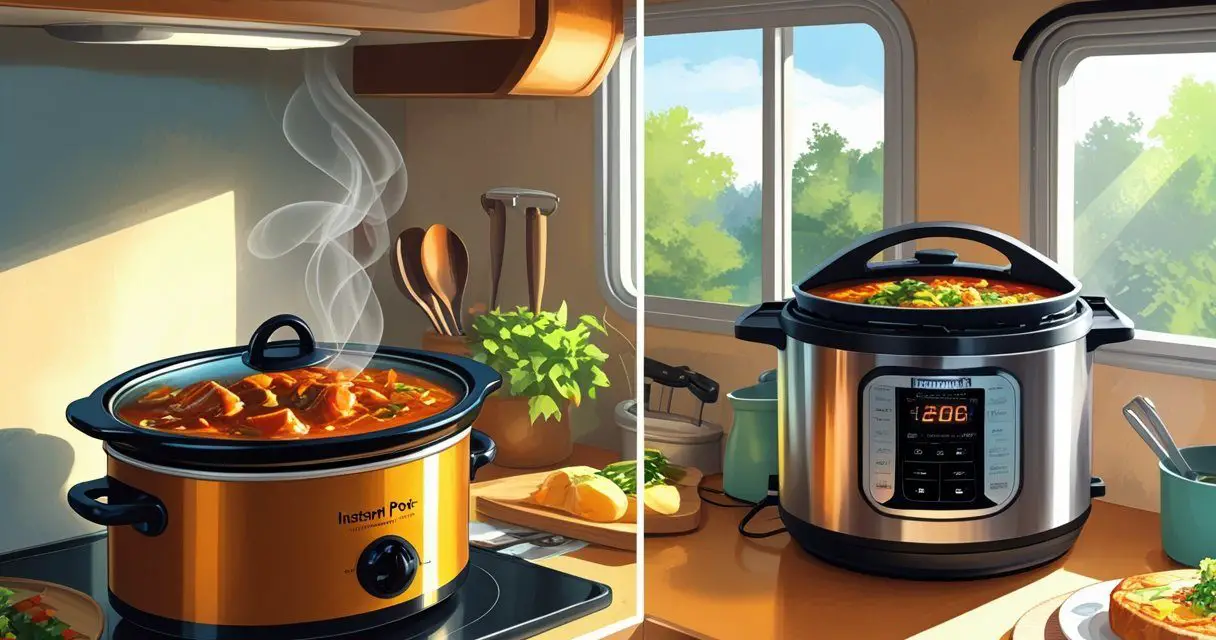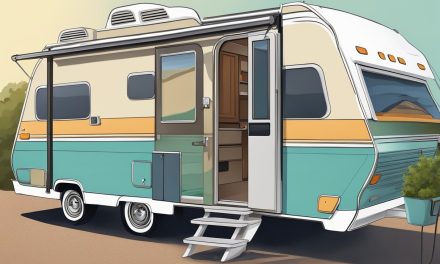Would you like to save this article?
Choosing between a slow cooker and an Instant Pot for your RV trips can make a big difference in how you cook and enjoy your meals on the road. Both options are popular, but the Instant Pot is usually a better fit for RV living because it’s more versatile and works faster while also saving space. It can work as a slow cooker, pressure cooker, and even more, so you get more for your limited counter space.
A slow cooker might be simpler and more reliable for some traditional recipes, but it takes hours to cook and uses energy over a longer period. If you’re short on time or want something that does it all, the Instant Pot stands out. Keep reading to find out which one matches your RV lifestyle best and get tips on making your meals easy and tasty while traveling.
Slow Cooker vs Instant Pot: What’s the Real Difference?
When you’re living in an RV, kitchen space is tight and power is limited. The right cooking appliance can save time, power, and storage space while helping you make tasty meals.
How Each Appliance Works
A slow cooker cooks food at low temperatures over several hours, usually between 4 and 10 hours. You put your ingredients in, set it, and let it cook all day with almost no watching.
An Instant Pot, on the other hand, is a pressure cooker that uses high pressure and heat to cook food much faster—sometimes just in minutes. It can also work as a slow cooker but with extra features, like sautéing and steaming.
Here’s a quick comparison:
| Appliance | Cooking Style | Speed | Typical Dishes |
|---|---|---|---|
| Slow Cooker | Low heat, long time | 4-10 hours | Stews, soups, roasts |
| Instant Pot | Pressure & high heat | 10-60 minutes | Beans, rice, meats, soups |
Cooking Functions and Versatility
A slow cooker usually has only a few settings—low, high, and maybe a keep-warm function. It’s simple and does one main job: gentle, all-day cooking.
An Instant Pot is more versatile. Most models have settings for pressure cooking, slow cooking, steaming, sautéing, making yogurt, and even cooking rice. You get more cooking options in one pot.
If you like making different types of meals, an Instant Pot gives you more flexibility. But if you mainly want to “set it and forget it” with easy, hearty dishes, a slow cooker might be enough.
Ease of Use in Small Spaces
Both appliances are compact, but some Instant Pots are bulkier because of extra parts and buttons. You’ll need to find a spot to store the lid and accessories.
The slow cooker has a simple interface—just turn the knob or press a button, and you’re done. The Instant Pot’s control panel has more buttons, which can be confusing at first.
Cleaning is straightforward for both, but Instant Pots often have a few more pieces to wash, like the rubber ring and inner lid. If you want to keep things as simple as possible in your RV kitchen, the slow cooker takes the lead. But if you want more options in one appliance, an Instant Pot may be worth the extra effort.
Choosing the Best Option for RV Living
When it comes to RV cooking, you need practical solutions that fit your space and match your needs. The best choice depends on how much room you have, your power setup, and how much time you want to spend making meals.
Space and Storage Considerations
RV kitchens are small, so space is always at a premium. Both slow cookers and Instant Pots come in different sizes, but Instant Pots are known for being multi-use. One 6-quart Instant Pot can replace several kitchen gadgets, like a rice cooker or steamer, which helps you save valuable storage.
A basic Crock-Pot or slow cooker is often lighter and a bit easier to store. However, it only does one thing—slow cook. If you want to minimize clutter, you might like the Instant Pot since it serves more than one function in a single device.
If cabinet or counter space is extremely limited, check the measurements before you buy. Some Instant Pots are bulkier than slow cookers, so make sure whatever you pick actually fits in your RV kitchen.
Power Usage and Efficiency
Electric cooking appliances pull power from your RV’s system, so you’ll need to know how much your setup can handle. An Instant Pot typically uses more power while operating (around 700-1000 watts) but cooks food much faster. A slow cooker uses less power per hour (often 150-250 watts) but needs to run for a longer time.
If you have a solar setup or rely on batteries, compare total energy use. For example, the Instant Pot might use more watts, but it could finish in 30 minutes while a slow cooker might use fewer watts an hour but needs 6-8 hours. Instant Pots can be a bit more efficient overall, especially when you want to cook fast and save on battery drain.
People who camp with full electricity hookups probably won’t notice much difference in power bills. For boondocking or dry camping, every watt counts, so check your RV’s limits before plugging in either option.
Meal Prep and Cooking Times
How much time do you want to spend cooking? Slow cookers are great if you like to set and forget your meals. You can prep breakfast or dinner in the morning, leave for the day, and come back to food that’s ready to eat.
Instant Pots are best for quick meals or when you forget to plan ahead. You can make soups, stews, or even rice in under an hour. Plus, you don’t have to thaw meat first, which is useful when plans change.
If you want flexibility, an Instant Pot gives you both fast-cook and slow-cook options. If you only slow cook, a Crock-Pot is simple and reliable. Here’s a quick comparison:
| Cooker | Typical Cook Time | Hands-On Time | Versatility |
|---|---|---|---|
| Slow Cooker | 4-8 hours | Very Low | Slow cook only |
| Instant Pot | 20-60 minutes | Low | Pressure, slow, more |
Choose what matches your routine and cooking style.
Practical Tips for Cooking on the Road
Cooking in your RV can be easy and safe with the right habits. Staying on top of safety and cleaning makes using your slow cooker or Instant Pot simple, so you can focus on your meal.
Safety Tips for Appliances in RVs
Always use your slow cooker or Instant Pot on a stable, flat surface to prevent spills. Look for a spot far from curtains, paper towels, and other things that could catch fire. Make sure your appliance’s cord is not stretched where someone could trip over it.
Plug the cooker straight into a wall outlet, not an extension cord or power strip. RVs can have limited power, so check your circuit’s limits before running multiple big appliances at once.
For extra safety, keep a small fire extinguisher nearby in your RV kitchen. Never leave cooking food completely unattended, even with slow cookers. Make sure the appliance vent is not blocked and leave enough space around it for steam to escape.
Cleaning and Maintenance on the Go
After each use, always unplug the cooker and let it cool down. Wipe the outside with a damp cloth, and wash the inner pot and lid using warm, soapy water.
Bring a soft sponge and a small bottle of dish soap, since RV sinks are small and water is sometimes limited. If you have an Instant Pot, clean the sealing ring and steam valve regularly — food can get stuck there and cause odors or pressure problems.
Let all parts dry completely before reassembling and storing the appliance. Keep extra towels and a drying rack in your RV to help with air-drying when space is tight. Doing light cleaning each time keeps your appliance working well and saves time later.





